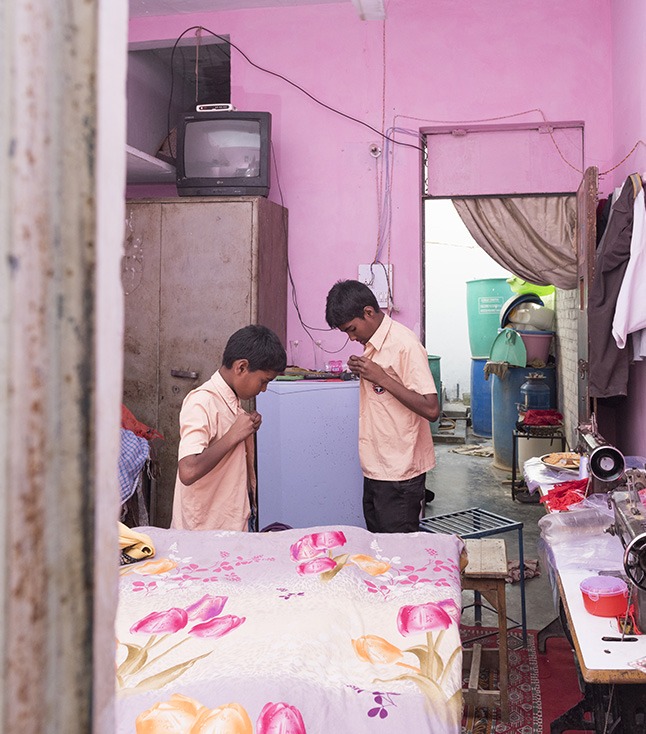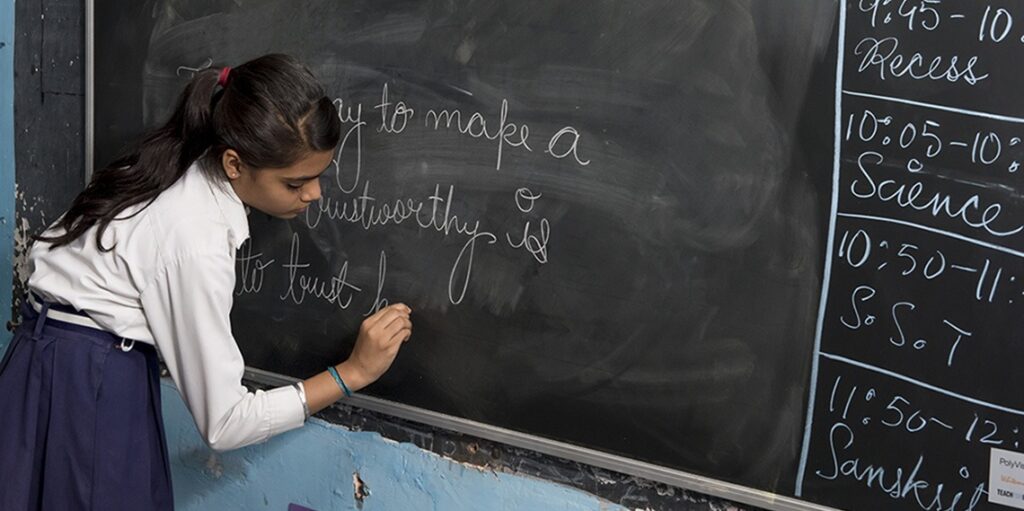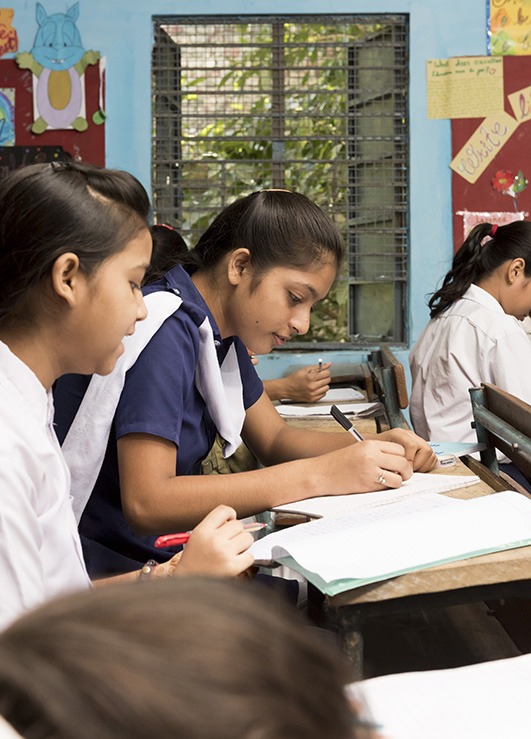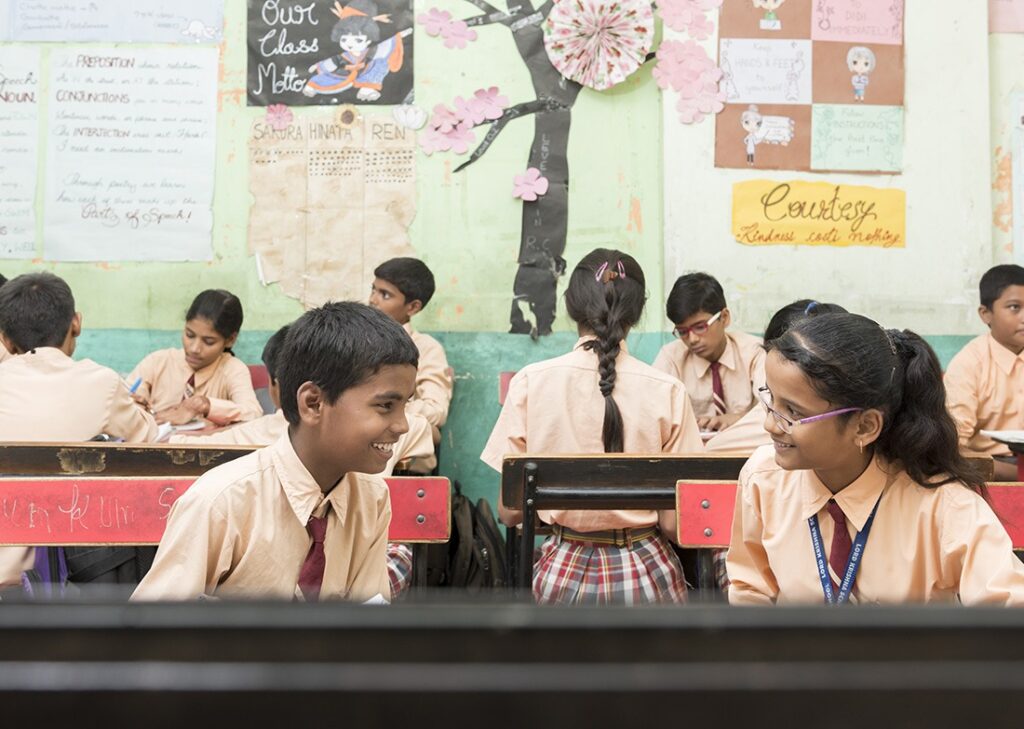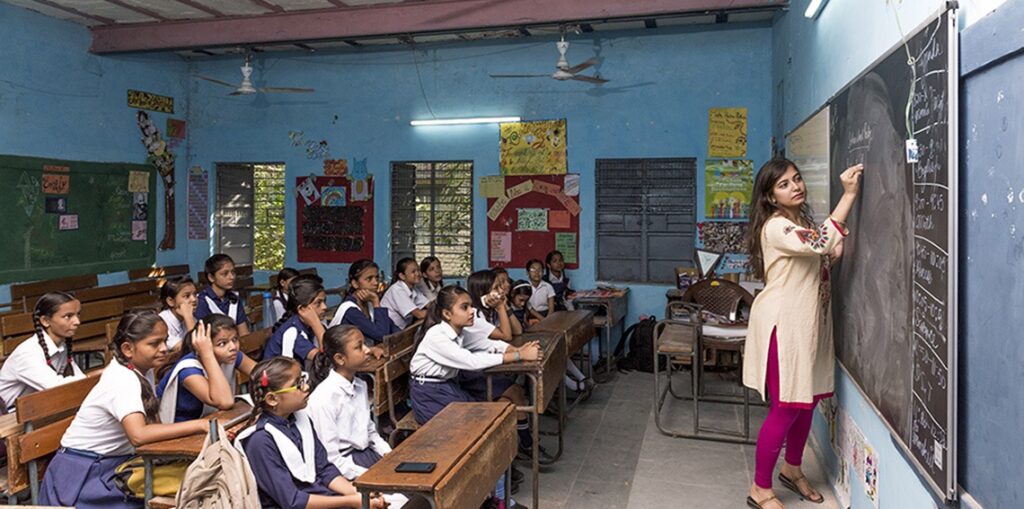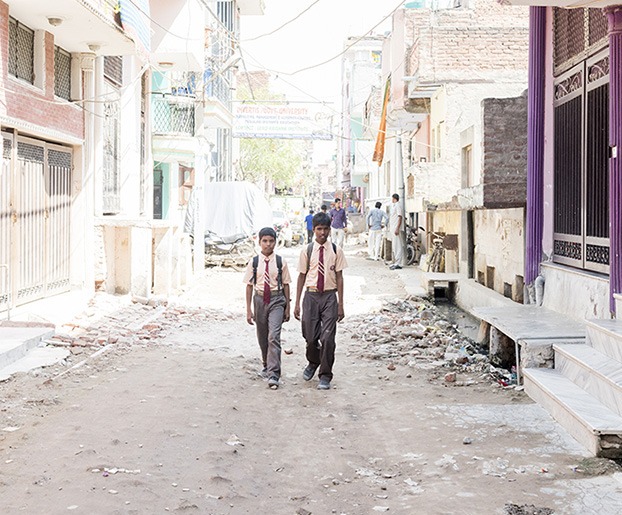India has been straining for years after an ambitious goal of educating all of its children, but is still struggling with low engagement in the classroom and a high dropout rate. Resources and ideas from countries with similar goals could help.
Haffizul and Abdul Rehman, brothers, rise from their shared bed in New Delhi, India, brush their teeth over a drain in the floor, and wake themselves up with a splash of water from a water barrel. They are getting ready to go to school.
This moment in these Indian boys’ morning— readying for the day—is something their parents and their parents before them experienced. The type of day that follows, however, is something entirely new. Instead of going to work as a shopkeeper like their dad, or as a tailor, like their mom, the boys, ages 12 and 14 are suiting up for a day at the Lord Krishna Public School. They are preparing for a different life in a different world.
India’s government is undergoing a massive and admirable effort to educate every last one of its children, having conducted 11 five-year plans that touch on education. But the hurdles here are many: infrastructure is lacking, and sometimes school bags, notebooks, food for lunch. Many children who attend school are the first in their families to do so. Often parents don’t understand the value of completing school or how to support their children, sometimes taking them to their home village for months at a time. These students often fall behind. Ultimately, India still faces the reality in which four percent of children never start school, 58 percent of children don’t complete primary school, and 90 percent of children don’t complete their schooling.
When the Rehmans finish buttoning their salmon pink uniforms and tying their burgundy ties, they hitch up their backpacks and start the walk to school, passing unfinished brick walls and wires hanging from buildings. Their destination is a noisy classroom. Taped up all over its walls are colorful pieces of paper encouraging “courtesy” and “kindness,” and crowding the floor space are about 35 worn, dirty two-person benches. The students are willing, but the resources are few.
A ROAD TO LEARNING
As part of its most-recent five-year plan, India aimed to cut dropout rates from 50 percent to 20 percent in primary schools, but failed to meet this goal when the clock ran out two years ago. Percentages and statistics like these seem like unfeeling data until one realizes that it means that nearly 1.4 million six- to 11-year-olds are not attending school, not learning, not preparing to do the jobs that their families and country will need them to do when they grow up.
The good news is that the first phase of the daunting task—just getting the children to school—has been remarkably successful, with 96 percent now enrolled, thanks to a push from the government. Infrastructure improvements—the number of schools now tops 1.4 million—have made it possible for almost all children to attend a primary school and upper primary school within walking distance. The new problem is that by graduation day, most of these gains are lost and the children are gone. Ninety percent of Indian children don’t complete their schooling.
India’s goal is to have 500 million people trained for the growing industries of the world by 2022. How will it reach that goal if in 2009, most of its population only had high-school educations; and if only 10 percent of its population goes on to university? It’s not for lack of desire that India is struggling to achieve its goal; the government spends the third largest amount on education after the United States and China. It’s that the task it set for such a large population is so noble, complex and daunting.
WORLD PARTNERS
India isn’t alone in this push. Other newly industrialized countries, such as China, Colombia, Sri Lanka and Bangladesh, are also racing to reform their education systems. Brazil, for example, has the same aim to universalize early childhood education as well as expand enrollments at the post-graduate level.
India isn’t without hope—or help, either. As one Brookings Institute report suggested, India can partner with other countries, such as the United States, and learn from its efforts to educate its population: “The U.S. and India can achieve better learning outcomes if they pool their experience and resources – both intellectual and economic.” One example of such a partnership is Teach for India, a not-for-profit modeled off of Teach for America, whose mission is to create a movement of leaders working to eliminate educational inequality in India.
The desire is that the enthusiasm of the Teach for India teachers, or fellows, who take two years out of their careers to teach, and who will likely go on to work for multinational corporations—one came to the nonprofit after an internship with Mercedes Benz—will help keep the students engaged and keep them in school. “Everyone has a right to education, so there is a high enrollment and parents are happy to send their children,” says Shifali Thakkur, manager of development and alumni impact for Teach for India. It’s the teachers’ jobs to keep them there.
Today 1,100 fellows work with 320-plus schools to educate 40,000 students in seven cities. And each year, the organization spreads its geographic wings, adding city after city, from Mumbai to Pune to Delhi to Hyderabad to Chennai to Ahmedabad to Bengaluru. To the students, the fellows stress the importance of taking ownership of their learning, their community; and awareness of their responsibilities at the personal, community and national level. To the government teachers, who suffer from absenteeism, they lead by example.
SOMETHING’S MISSING
In that same classroom in the Lord Krishna Public School, in which Abdul and Haffizul Rehman learn on their worn desks, the main teaching tool is a melamine board with scratches, dings and discoloration from marker residue. Teachers and students in other government classrooms may not be as lucky; the chalkboard at one secondary school for girls is simply a concrete wall painted with black paint. These writing surfaces make it an arduous and time-consuming task to teach. They’re hard for students to see and read, and hard to erase.
The students may be eager and the teachers inspired, but they all still have to work with underperforming resources. Fifth grade students are struggling to learn a level of comprehension of English that they should have understood three grades earlier. As Time magazine put it, “More children are going to school in India, but they’re learning less.”
Peter Lewchanin, general manager of Polyvision—the leading producer of e3 CeramicSteel surfaces—has visited Indian classrooms like this often, the last time in September and October of 2015 to observe the conditions of the government writing surfaces. “You can hardly read anything on the boards, they’ve been erased so many times,” he says. “They’re black with chalk marks all over them and the teachers are trying to write over that with chalk again.”
Chalkboards and whiteboards are a classic staple of education. Teachers in India and all over the world use boards as the primary classroom tool for teaching math, writing, literature, history, science and social studies. They also use it to display classroom administration: the date, the schedule for the day, class rules, reminders and upcoming due dates and events. Beyond teacher-to-student conveyance of information, though, large writing surfaces are also critical tools for more-active learning, in which teachers invite students to stand up and do math problems with their peers. Teach for India fellows such as those in the Lord Krishna Public School and the Government Girls SR Secondary School employ engaging strategies daily. If Indian schools had boards that were easier to use, children could take a substantial role in their educations. A University of Wisconsin study found that learning by quality visual aids can improve learning up to 200 percent. It’s by engaging the material on an analog tool with their brains as well as their bodies, that information is cemented more firmly in the children’s minds. The medium matters.
QUALITY WRITING BOARDS
Polyvision’s Lewchanin, recognizes the challenges in these schools and says, “It’s always a little humbling to see the spaces that the students work in. After having gone there a number of times, the question you start to ask is, ‘What can I do to help?’” One of the easiest and quickest solutions is replacing the writing surface.
Teachers that formerly used paint on concrete or scratched melamine and who get the chance to try premium writing boards find that their classrooms are revitalized. One teacher says, “ It is through visual aids like drawing and labeling that my young students increase their vocabulary. Being able to erase and write very fast helps me keep up with their energy levels.” With new boards, teachers are also able to leave information up on the board that students can reference while they do individual and group work, capturing information that is otherwise lost. Says another teacher, “I am able to utilize the time better now. I teach the lesson and tell students to copy the notes and when they are copying the notes, I write on the other board and keep their next exercise ready so that once they are done they don’t feel restless.”
Shifali Thakkur, a woman who finished her fellowship with Teach for India in April of 2015, teaches grades three and four in a low-income school. She understands the problem on a personal level. When she taught she first used one of those old blackboards until she got fed up with the headaches that the chalk dust caused and spent her own money to get a better writing surface. “After getting the whiteboard the students were able to read my handwriting and it helped them to understand the teaching better,” she says. “A whiteboard makes it easier for a kid to copy what’s on the board or with their tiny hands, to write on the board.”
The average age in India is under 30, so there is a ready market for education and a vast need to supply students with the tools they need. It’s a young country hungry to be more and more competitive in the market. Most of the whiteboards and chalkboards used in Indian classrooms are made of painted steel and only last about three to four years. Advanced whiteboards and chalkboards, however, endure. They are a onetime investment for schools. As Tarun Periwal, director of Whitemark Limited in New Delhi, which distributes Polyvision’s e3 CeramicSteel, says, “This will be the next generation to lead the country—or the world.” How good it will be if they’re educated at the start as they need to be at the finish.
In the Lord Krishna Public School classroom today, Abdul writes on a new whiteboard with red marker, solving problems and practicing his writing. Haffizul has his black marker to do the same.
So many of the world’s problems seem to need macro solutions, when often, it’s the micro solutions, the one-to-one efforts that work the best. For education one quality writing surface plus one dedicated teacher seems to be the correct arithmetic for effecting positive change.
MAKING A DIFFERENCE
Polyvision decided to donate e3 CeramicSteel whiteboards and chalkboards to schools served by Teach for India, a six-year-old non-profit modeled after Teach for America. Like its counterpart in the United States, Teach for India pairs under resourced schools with recent university graduates for two years.
By partnering with local, Indian organizations already deep in the trenches, Polyvision was able to identify schools with real needs and engaged teachers. “We see a difference in the students when the teachers are engaged and encouraged to help their students,” Shifali Thakkur, a recent Teach for India fellow, says. “They help create more structure and even extracurricular activities.” One current Teach for India fellow in a government school for girls is so passionate about poetry that she has her students participate in so-called “poetry slams,” a competition in which students recite their original poetry in front of the class.
Polyvision chose to donate hundreds of its e3 CeramicSteel whiteboards and chalkboards, specifically. The boards come with a lifetime warranty, making them long-lasting tools. They are scratch, marker, graffiti, and fire-resistant. What gives the boards their steadfastness is the proprietary manufacturing process, which bonds porcelain enamel to metal by fusion at a super-high temperature. The result is the prime choice for demanding and highly active environments ranging from applications for writing surfaces to architectural cladding around the world. The hope is that Polyvision’s investment pays off with a new generation of leaders for the rest of the world to partner with.
